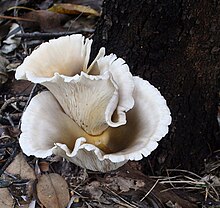
Back Omphalotus nidiformis AST Omphalotus nidiformis Bulgarian Omphalotus nidiformis CEB Omphalotus nidiformis Czech Australischer Geisterpilz German Omphalotus nidiformis Spanish Omphalotus nidiformis Basque Omphalotus nidiformis French Omphalotus nidiformis Portuguese Omphalotus nidiformis Swedish
| Omphalotus nidiformis | |
|---|---|

| |
| Scientific classification | |
| Domain: | Eukaryota |
| Kingdom: | Fungi |
| Division: | Basidiomycota |
| Class: | Agaricomycetes |
| Order: | Agaricales |
| Family: | Omphalotaceae |
| Genus: | Omphalotus |
| Species: | O. nidiformis
|
| Binomial name | |
| Omphalotus nidiformis (Berk.) O.K. Mill. (1994)
| |
| Synonyms | |
|
Species synonymy[1]
| |
| Omphalotus nidiformis | |
|---|---|
| Gills on hymenium | |
| Cap is infundibuliform | |
| Hymenium is decurrent | |
| Stipe is bare | |
| Spore print is white | |
| Ecology is saprotrophic or parasitic | |
| Edibility is poisonous | |
Omphalotus nidiformis, or ghost fungus, is a gilled basidiomycete mushroom most notable for its bioluminescent properties. It is known to be found primarily in southern Australia and Tasmania, but was reported from India in 2012 and 2018. The fan or funnel shaped fruit bodies are up to 30 cm (12 in) across, with cream-coloured caps overlain with shades of orange, brown, purple, or bluish-black. The white or cream gills run down the length of the stipe, which is up to 8 cm (3 in) long and tapers in thickness to the base. The fungus is both saprotrophic and parasitic, and its fruit bodies are generally found growing in overlapping clusters on a wide variety of dead or dying trees.
First described scientifically in 1844, the fungus has been known by several names in its taxonomic history. It was assigned its current name by Orson K. Miller, Jr. in 1994. Its epithet name is derived from the Latin nidus "nest", hence 'nest shaped'. Similar in appearance to the common edible oyster mushroom, it was previously considered a member of the same genus, Pleurotus, and described under the former names Pleurotus nidiformis or Pleurotus lampas. Unlike oyster mushrooms, O. nidiformis is poisonous; while not lethal, its consumption leads to severe cramps and vomiting. The toxic properties of the mushroom are attributed to compounds called illudins. O. nidiformis is one of several species in the cosmopolitan genus Omphalotus, all of which have bioluminescent properties.
© MMXXIII Rich X Search. We shall prevail. All rights reserved. Rich X Search